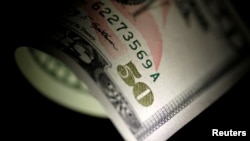The U.S. economy likely maintained a brisk pace of growth in the fourth quarter, driven by an acceleration in consumer and business spending, which could set it on course to attain the Trump administration’s 3 percent annual growth target this year.
Gross domestic product probably increased at a 3.0 percent annual rate also boosted by a rebound in homebuilding investment and a pickup in government outlays, according to a Reuters poll of economists. The strong growth pace would come despite anticipated drags from trade and inventory investment.
It would follow a 3.2 percent pace of expansion in the third quarter and mark the first time since 2004 that the economy enjoyed growth of 3 percent or more for three straight quarters.
The Commerce Department will publish its advance fourth-quarter GDP estimate Friday morning.
Global rebound
The economy’s growth spurt is part of a synchronized global rebound that includes the euro zone and Asia.
It has also benefited from President Donald Trump’s promise of hefty tax cuts, which was fulfilled in December when the Republican-controlled U.S. Congress approved the largest overhaul of the tax code in 30 years.
Despite the economy’ strong performance in the last three quarters of 2017, overall growth for the year is expected to come in around 2.3 percent, because of a weak first quarter.
That would still be an acceleration from the 1.5 percent logged in 2016. Economists expect annual GDP growth will hit the government’s 3 percent target this year, spurred in part by a weak dollar, rising oil prices and strengthening global economy.
Modest boost from tax cuts
While the corporate income tax rate has been slashed to 21 percent from 35 percent and taxes for households have also been lowered, economists see only a modest boost to GDP growth as the fiscal stimulus is coming at a time when the economy is almost at full employment.
“We are encouraged by the current breadth of economic strength and ... we expect the pace of U.S. real GDP to accelerate from the expansion average, increasing 3.0 percent in 2018,” said Sam Bullard, a senior economist at Wells Fargo Securities in Charlotte, North Carolina.
Fed hawks
Robust economic growth has been accompanied by record gains on the stock market and a strong labor market, with the unemployment rate falling seven-tenths of a percentage point last year to a 17-year low of 4.1 percent. Economists said this could put the Federal Reserve on a more aggressive path of interest rate increases than is being anticipated.
“I think that gives the hawks at the Fed more ammunition to say we should contemplate a more aggressive path on rates going forward,” said Scott Anderson, chief economist at Bank of the West Economics in San Francisco.
The U.S. central bank has forecast three rate hikes this year, the same number as in 2017.
Consumer spending
Consumer spending, which accounts for more than two-thirds of U.S. economic activity, is expected to have increased by as much as a 3.9 percent rate in the fourth quarter. That would be the quickest pace in three years and would follow a 2.2 percent rate of growth in the July-September quarter.
Consumer spending is likely to remain supported by rising household wealth, thanks to the stock market rally and higher house prices, tax cuts and firming wage growth as companies compete for workers and some states raise the minimum wage.
“Since the election the consumer has been exuding confidence, which is the willingness to spend money, and we see he has got even the ability to spend money too because personal income is creeping up,” said Dan North, chief economist at Euler Hermes North America in Baltimore.
“So, you have the willingness and ability to spend. We think consumption is going to pick up and drive the economy.”
Business investment in equipment is expected to have picked up from the third-quarter’s 10.8 percent growth pace. Spending on equipment is likely to be underpinned this year by the corporate income tax cuts and recent increase in crude oil prices.
Investment in homebuilding is expected to have rebounded after contracting for two straight quarters. An acceleration is expected in government spending from the July-September period’s pedestrian 0.7 percent growth pace.
Trade a drag
But trade was likely a drag on GDP growth as the burst in consumer spending was probably satiated with imports, offsetting a rise in exports, which is being driven by dollar weakness.
Economists at JPMorgan estimate that trade cut one percentage point from fourth-quarter GDP growth after adding 0.36 percentage point in the third quarter.
Inventory investment also probably subtracted from GDP growth last quarter after adding 0.79 percentage point to output in the prior period.











